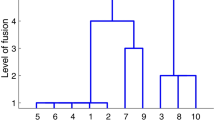Abstract
K-means algorithm is a well known nonhierarchical method for clustering data. The most important limitations of this algorithm are that: (1) it gives final clusters on the basis of the cluster centroids or the seed points chosen initially, and (2) it is appropriate for data sets having fairly isotropic clusters. But this algorithm has the advantage of low computation and storage requirements. On the other hand, hierarchical agglomerative clustering algorithm, which can cluster nonisotropic (chain-like and concentric) clusters, requires high storage and computation requirements. This paper suggests a new method for selecting the initial seed points, so that theK-means algorithm gives the same results for any input data order. This paper also describes a hybrid clustering algorithm, based on the concepts of multilevel theory, which is nonhierarchical at the first level and hierarchical from second level onwards, to cluster data sets having (i) chain-like clusters and (ii) concentric clusters. It is observed that this hybrid clustering algorithm gives the same results as the hierarchical clustering algorithm, with less computation and storage requirements.
Similar content being viewed by others
References
J. A. Hartigan,Clustering algorithms (Wiley, New York, 1975).
M. R. Anderberg,Cluster analysis for applications (Academic Press, New York, 1973).
M. Narasimha Murty and G. Krishna, “A computationally efficient technique for data-clustering,”Pattern Recognition, Vol. 12, pp. 153, 1980.
J. B. MacQueen, “Some methods for classification and analysis of multivariate observations,”Proc. Symp. Math. Stat. and Probability, 5th, Berkely, AD 669871 (Berkeley, 1967), pp. 281.
D. J. McRae, “MIKCA: A FORTRAN IV iterative k-means cluster analysis program,”Behavioral Science, Vol. 16, pp.423 (1971).
M. M. Astrahn, “Speech analysis by clustering or the hyperphoneme method,”Stanford artificial intelligence project, AD 709067 (Stanford Univ., California, 1970).
G. H. Ball and D. J. Hall, “PROMENADE-An outline pattern recognition system,”RADC-TR-67-310, AD 822174 (Stanford Res. Inst, California (1967), pp. 72.
G. Nagy, “State of the art in pattern recognition,”Proc. IEEE, Vol. 56, pp. 836 (May 1968).
Author information
Authors and Affiliations
Rights and permissions
About this article
Cite this article
Murty, M.N., Krishna, G. A hybrid clustering procedure for concentric and chain-like clusters. International Journal of Computer and Information Sciences 10, 397–412 (1981). https://doi.org/10.1007/BF00996137
Received:
Revised:
Issue Date:
DOI: https://doi.org/10.1007/BF00996137




